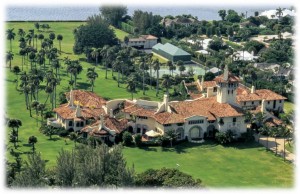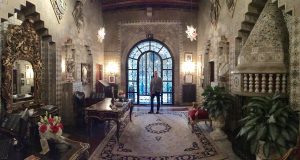 Silvin describes the mansion’s construction, which started in 1924 at the height of Florida’s construction boom. Completed in 1927 when the Florida real estate and banking bubbles had burst, Mar-a-Lago’s 600 construction workers helped support the local economy. The fortune that paid for the construction came from the Post Cereal empire founded by C.W. Post in 1895. His only daughter, Marjorie Merriweather Post, inherited the Postum Cereal Company, and turned it into General Foods in 1923, creating one of America’s greatest fortunes.
Silvin describes the mansion’s construction, which started in 1924 at the height of Florida’s construction boom. Completed in 1927 when the Florida real estate and banking bubbles had burst, Mar-a-Lago’s 600 construction workers helped support the local economy. The fortune that paid for the construction came from the Post Cereal empire founded by C.W. Post in 1895. His only daughter, Marjorie Merriweather Post, inherited the Postum Cereal Company, and turned it into General Foods in 1923, creating one of America’s greatest fortunes. In the hope of turning the estate into a Winter White House for future Presidents and foreign dignitaries, Mrs. Post’s Will bequeathed the house to the United States Government. As was the case with similar “gifts” of huge mansions to public organizations, Mar-a-Lago was deemed too expensive to maintain, and it was given back to the Post Foundation. Mar-A-Lago fortunately gained landmark status in 1980, at the beginning of landmarking in Palm Beach, which saved the mansion.
In the hope of turning the estate into a Winter White House for future Presidents and foreign dignitaries, Mrs. Post’s Will bequeathed the house to the United States Government. As was the case with similar “gifts” of huge mansions to public organizations, Mar-a-Lago was deemed too expensive to maintain, and it was given back to the Post Foundation. Mar-A-Lago fortunately gained landmark status in 1980, at the beginning of landmarking in Palm Beach, which saved the mansion.